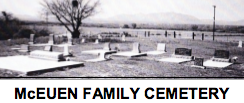In 1870, my great-grandfather — tiring of working on his father’s tobacco plantation in Kentucky — started his long journey west, beginning in Texas. There, he went into the cattle business. To make a long story short, his family of six boys and three girls drove a large herd of cattle west and arrived in the Gila Valley, Arizona Territory, in 1890.
In early Arizona, copper, cattle, and cotton were the main sources of revenue. Cattle raising hit a peak in 1891 when tax rolls showed nearly 75 million head of cattle in the territory. After drought and overgrazing took their toll on the land, the Forest Service adopted several rules, including the leasing of public lands on which cattle ran. My family’s grazing land was north of Ft. Thomas in the Gila Mountains.
Cattle rustling — not only by the Indians, but by neighbors as well — understandably caused a lot of hard feelings. In my grandfather’s 1914 diary account, M. Cummings was arrested for shooting our McEuen family cattle. Among many family stories, I remember hearing how the thieves would bury the branded hide to destroy evidence of ownership. My grandfather’s brand was RAY and my mother’s was Diamond Y. As soon as a child was born, his brand was registered in the Territory’s brand book.
Roundup was a work intensive event, engaging all who could sit on a horse. The cattle were driven to holding pens near the train station at Geronimo for shipment. Railroad construction had been halted at that location in 1896, when the San Carlos Apache tribe refused to give the owners of the company permission to cross the reservation. Three years later, permission was granted, and the railroad eventually reached Globe.
Beginning in the 1870s, the Indians were put on reservations, and a series of military camps and forts was established throughout the area to contain and control the Apaches. Ft. Thomas was the army post near the ranch. During this era, the Apaches caused a few deaths, but it was their stealing of cattle, horses, and food that spread fear and loathing among the families here. The Apache leader, Geronimo, surrendered after an armed protest in 1886; the fears and concerns then faded away.
My great-grandparents’ home served as headquarters for itinerant preachers riding the circuit. As a grown woman, my mother couldn’t remember whether she had been baptized; what she could remember was the entire community being dunked in the Gila River whenever a preacher happened to be among them. She concluded that she probably had, at some point, been “baptized.”
As each son married, he was given a section of land and a house. Eventually, the McEuen ranch included six houses, plus the parents’ homestead, corrals, sheds, etc.
My grandparents wed in 1904. My mother, Garnet McEuen Vest Byers, was born in 1906.
My great-grandfather helped build a schoolhouse in Shiloh, a small settlement across the river from his ranch, which also doubled as a church. Education was always important to my family. In the fall of 1897, there were enough McEuen cousins and neighbors to form a school district. Although there was only one teacher at the school, they all received as good an education there as they would have anywhere else. When my mom finished the eighth grade, she was sent to Globe to live with her grandmother and attend high school.
She began her freshman year at Tempe Normal School, now ASU, in 1923. She later graduated in 1925 with a degree in education, and then began her teaching career at only 18 years old.
Entertainment at the ranch was limited, but lively. Nearby was the most popular attraction in Gila Valley — the Indian hot springs, built in 1903. Fed by natural artesian springs, it served as a swimming pool. Mom remembers seeing tables for dining set up in the shade of huge trees, as well as uniformed waiters who were very formal for such a casual setting. Dancing was a popular form of entertainment; the musicians usually played violin, accordion, and fiddle. Local groups performed plays, songs, and poetry recitations.
I guess it is only fitting that this small review of rural Arizona Territory life should include a photo of the McEuen family cemetery, with the Gila mountains visible in the background. My great-grandparents, grandparents, aunts, uncles, and cousins — as well as infants, sadly, who didn’t survive their birth or succumbed early to disease — are buried here. After each visit to this place, I come away with a clearer view of who I am and how important family is to me.









